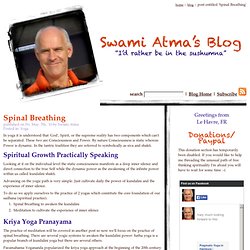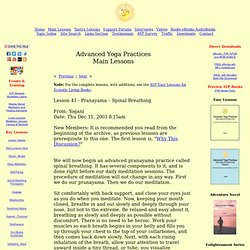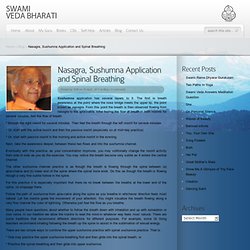

Kriya Yoga Secrets 1 - Burning Negative Karma. Spinal Breathing. In yoga it is understood that 'God', Spirit, or the supreme reality has two components which can't be separated.

These two are Consciousness and Power. By nature Consciousness is static whereas Power is dynamic. In the tantric tradition they are referred to symbolically as siva and shakti. Spiritual Growth Practically Speaking Looking at it on the individual level the static consciousness manifests as a deep inner silence and direct connection to the true Self while the dynamic power as the awakening of the infinite power within us called kundalini shakti. Advancing on the yogic path is very simple. To do so we apply ourselves to the practice of 2 yogas which constitute the core foundation of our sadhana (spiritual practice). Spinal Breathing to awaken the kundalini Meditation to cultivate the experience of inner silence Kriya Yoga Pranayama The practice of meditation will be covered in another post so now we'll focus on the practice of spinal breathing. Spinal Breathing Technique Relaxation.
AYP Lesson 41 - Spinal Breathing Pranayama. Note: For the complete lessons, with additions, see the AYP Easy Lessons for Ecstatic Living Books.

Lesson 41 - Pranayama – Spinal Breathing From: Yogani Date: Thu Dec 11, 2003 8:15am New Members: It is recommended you read from the beginning of the archive, as previous lessons are prerequisite to this one. The first lesson is, "Why This Discussion? " We will now begin an advanced pranayama practice called spinal breathing. Sit comfortably with back support, and close your eyes just as you do when you meditate. Begin by doing this spinal breathing practice for five minutes before your regular meditations. In a week or so, or whenever you are feeling steady with the ten minutes of pranayama before your meditation, add the following features: On the exhalations, allow your epiglottis to close enough so that there is a small restriction of the air leaving your lungs. While all of these mechanical actions may seem complicated at first, they will quickly become habit as you practice.
Soham Mantra. Vedas affirms the truth that "Speech is the essence of humanity" as ideas remain unutilized if not spoken.

Mantras, which are indeed the energy-based, sounds therefore aids in taming the mind whilst regulating the nervous system. The soham mantra is a natural mantra in meditation, which is derived, as sooo is the sound of inhalation and hummm…. is the sound of exhalation. This has been called the universal mantra because its vibration plays an important part in breathing. Soham mantra is practiced at a steady, slow speed with longer exhalation and thus regulates the nervous system, relaxes the body, and quiets the mind.
It is the finest, easiest and most direct ways to train the breath. The deeper ways to use the soham mantra is through spinal breath by coordinating body, breath and mind. Nasagra, Sushumna Application and Spinal Breathing. Sushumna application has several layers to it.

The first is breath awareness at the point where the nose bridge meets the upper lip, the point known as nasagra. From this point the breath is then observed flowing from nasagra to the ajna-cakra. After feeling the flow of breath in both nostrils for several minutes, feel the flow of breath * through the right nostril for several minutes. Then feel the breath through the left nostril for several minutes. * Or, start with the active nostril and then the passive nostril (especially so at mid=day practice) * Or, start with passive nostril in the morning and active nostril in the evening. Next, take the awareness deeper, between these two flows and into the sushumna channel. Eventually with this practice, as your concentration improves, you may volitionally change the nostril activity from side to side as you do the exercise.
Follow the path of sushumna from ajna-cakra along the spine as you breathe in whichever direction feels most natural.